Verdict
The MymonX offers big health monitoring features, but is ultimately let down by hardware and software problems that make it tough to recommend over similarly priced health-focused smartwatches.
Pros
- Comfortable to wear
- Good battery life
- Some good ECG data
Cons
- Not hugely accurate a lot of the time
- Watch and app software very disconnected
- Sports tracking issues
-
Non-invasive glucose monitoringCan determine your glucose measurements without the need for blook pricks. -
ECG measurementsCan measure the electrical activity of the heart to assess your heatlh. -
Blood pressure monitoringCan determine whether you have high or low blood pressure.
Introduction
The MymonX is a smartwatch that promises to track your vitals, including one that hasn’t been offered by any high profile smartwatch.
AITIS, the makers of MymonX, says its watch packs in medical-grade sensors that can non-invasively track glucose, which is something the likes of Apple and Samsung are continually rumoured to be striving to add to their respective smartwatches.
This is also a smartwatch that can track blood pressure, take ECG readings and monitor SpO2, respiratory rate, body temperature, all while offering some sports and fitness tracker features to make it useful outside of the more serious health monitoring time.
It’s a watch that packs in some pretty big and potentially groundbreaking features, so does it deliver where it matters? Here’s my take.
Design and screen
- 51mm case
- 1.3-inch TFT display
- IP68 water resistance level
If you’re hoping that the MymonX is going to bring some serious styling to your wrist, then you’re going to be disappointed. It’s very much in that category of ordinary looking smartwatches and reminds me a lot of the cheaper smartwatches I’ve tested from the likes of Realme, Poco and Mobvoi.
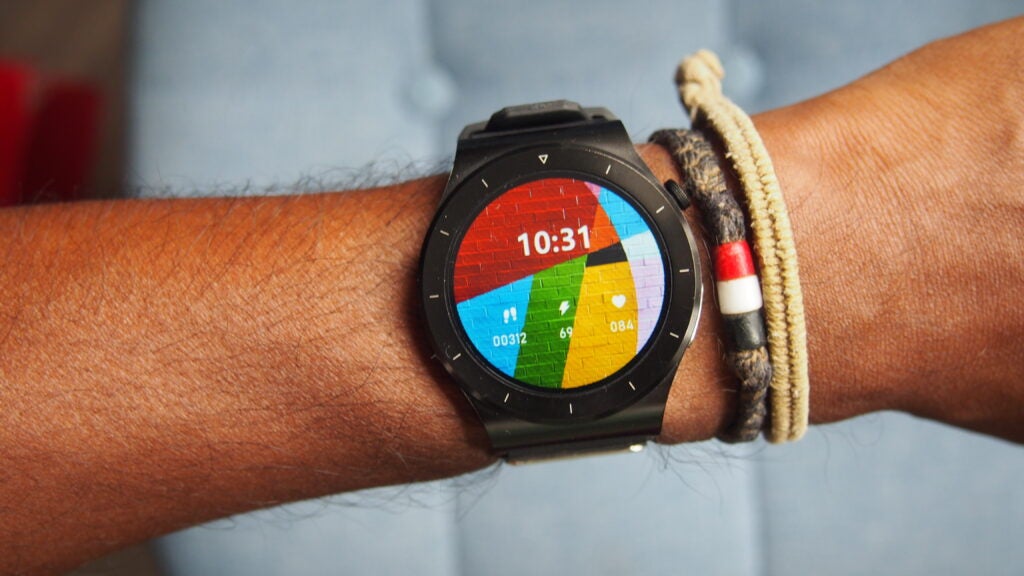
It’s built from stainless steel and a metal alloy with plastic and 316 medical steel around the back and that’s connected to a leather and TPU plastic strap with a traditional watch buckle that has been comfortable to wear and hasn’t caused any sort of irritation.
There’s just the one black colour option with scope to change up the straps, and while it feels pretty well built it’s just quite an uninspiring watch to peer down at.
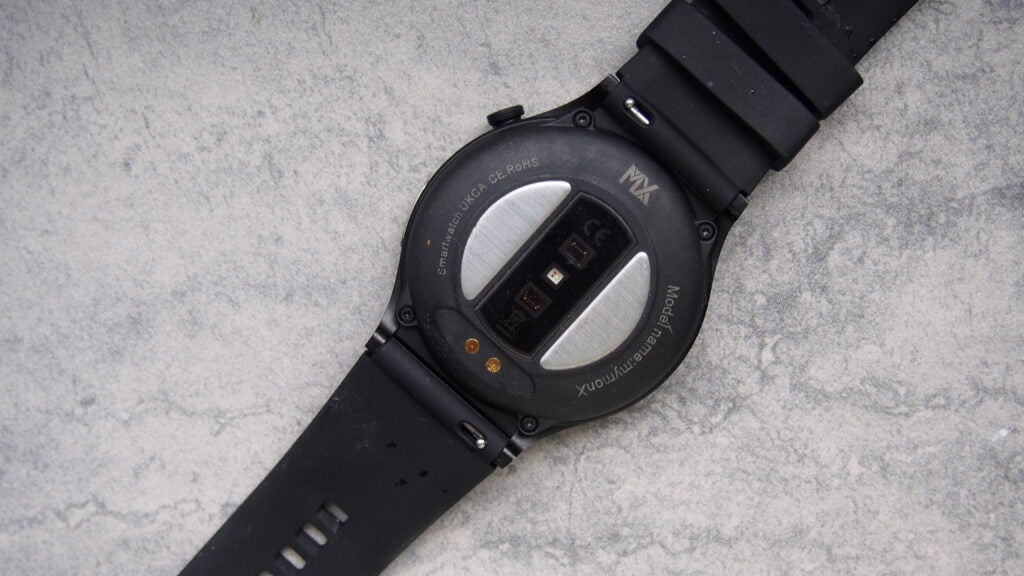
Weight-wise, it drops on the scales at 200g, so compare that to something like the new Samsung Galaxy Watch 6 Classic (52g-59g) and it’s a little on the heavy side. It measures in at 11.8mm thick, so it’s not a chunky watch at least, and while you don’t feel that weight, it certainly doesn’t disappear on the wrist either.
There’s one physical button to wake up the screen and get into the main menu screen. And below that there’s what looks like a larger, flatter button. That’s actually the electrode to place your finger onto to take ECG measurements.
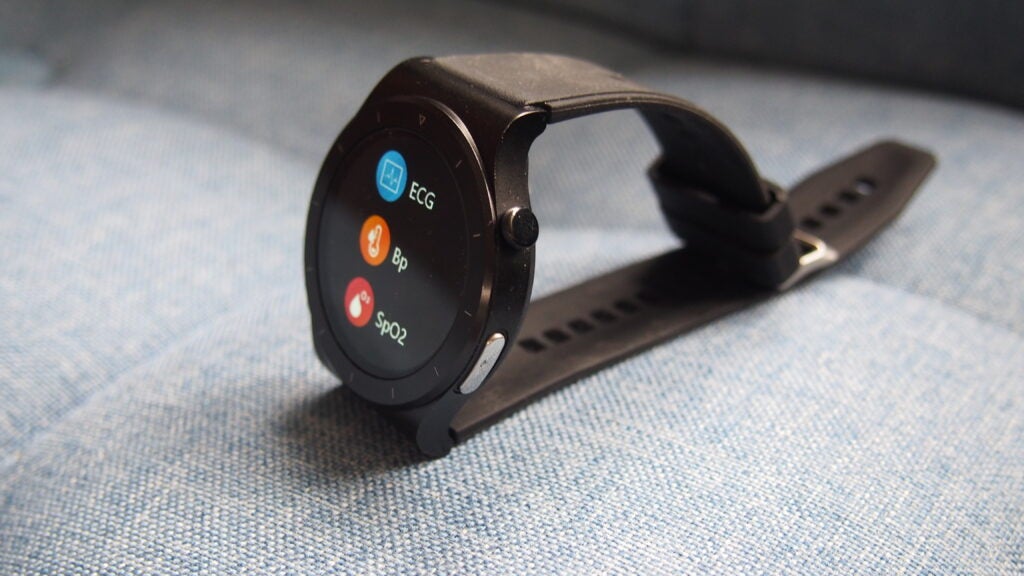
You’ll be staring into a pretty muted, 1.3-inch, 240 x 230 TFT touchscreen display, which again is the kind of screen you’d associate on much cheaper smartwatches. That does mean you get some colour, but it’s not rivalling the quality you’ll get on an AMOLED. It’s not a hugely bright screen either, with just 3 brightness settings to choose from and you can’t keep the display on 24/7 either.
AITIS does give its watch an IP68 water resistance design, which does mean it can handle some time being submerged in water up to 1.5 metres depth and offers some protection against dust as well.
Health tracking
- Non-invasive glucose tracking
- Blood pressure monitoring
- Takes ECG measurements
This smartwatch is really about what it can offer in terms of measuring your vitals, particularly the promise it can monitor blood glucose levels continuously. No high-profile smartwatch has promised this and most experts I’ve spoken to in this space suggest getting the level of accuracy with non-invasive glucose monitoring is extremely challenging.
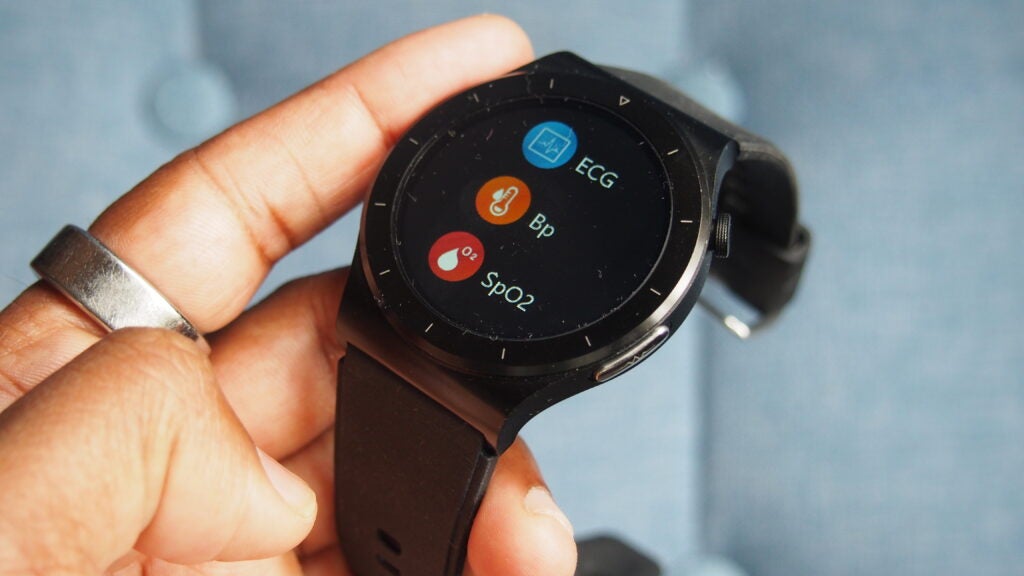
Interestingly, MymonX claims this isn’t a medical device and shouldn’t be used in the treatment of any medical condition. Based on my time with it, I’m not sure the data or the experience of grabbing that data feels good enough or better than what other smartwatches currently offer to make it wholly useful on that front.
Starting with the non-invasive glucose monitoring, which MymonX claims is AI-based, non-invasive monitoring and inside of the companion phone app will show real-time readings in mmol/L along with highest and lowest readings.
I wore a Supersapiens glucose monitoring device at the same time as testing the MymonX watch. Like the watch, it’s not designed for medical use, but is similar to the setup of its Freestyle Libre setup for those wanting to closely monitor glucose for health reasons. It’s also an invasively applied device designed to offer accurate data over a 14-day period.
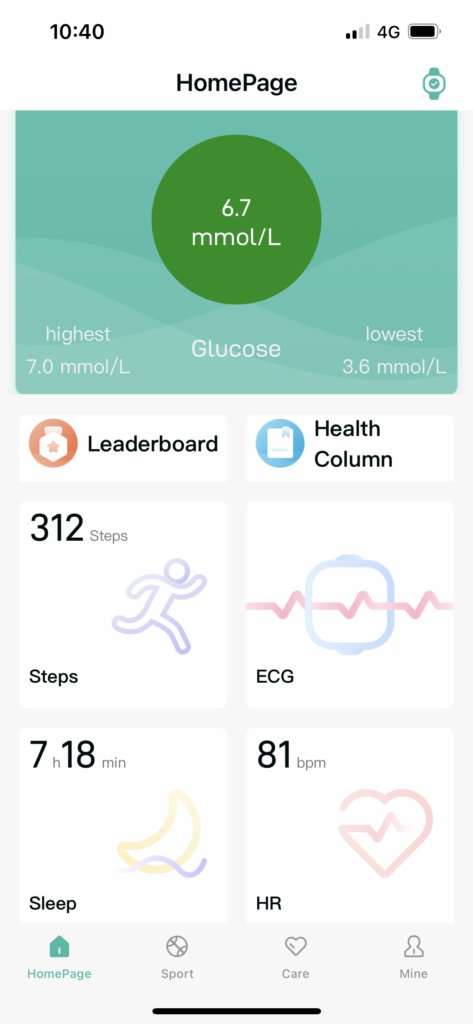
Comparing the readings they generally never seemed to match. The readings on the MymonX didn’t appear to show a spike or drop at times I’d expected it to, like after exercise or after eating a meal and largely the readings just seemed to hover at the same real-time and continuous readings most of the time.
Next was the ECG measurements, which fared a bit better on the accuracy front, but illustrates some of the disconnect between the app and the watch. You start ECG measurements from the app or the watch, with the latter done by placing your finger on the electrode. Taking a recording on the watch itself did work, but data never synced over.
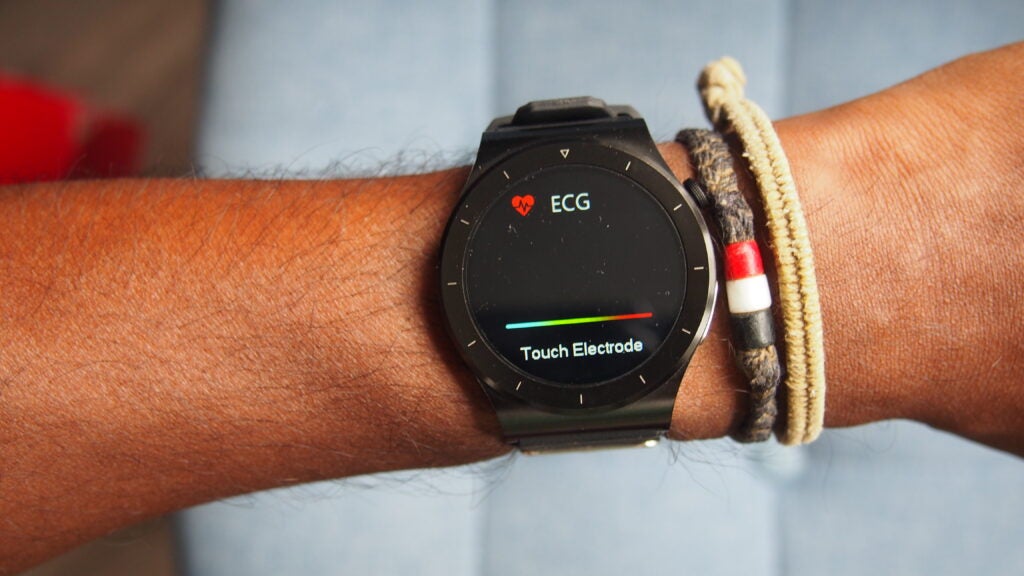
It worked fine when prompting a measurement from the app, which emits a loud beep as it’s taking readings. This generates heart rate, blood pressure and heart rate variability measurements. The ECG measurements in general did match what I grabbed from the Apple Watch and its built-in ECG sensor. So the data looks good, it’s just the execution of getting that data that’s the problem here.
Onto blood pressure monitoring where you can take readings directly from the watch through the optical sensors or you can do the above ECG measurement to get them. Either way, I took readings alongside a dedicated blood pressure monitor and they rarely matched and were generally off my usual readings. You can set your typical readings in the app to calibrate it in the app and without doing that it doesn’t seem highly reliable.
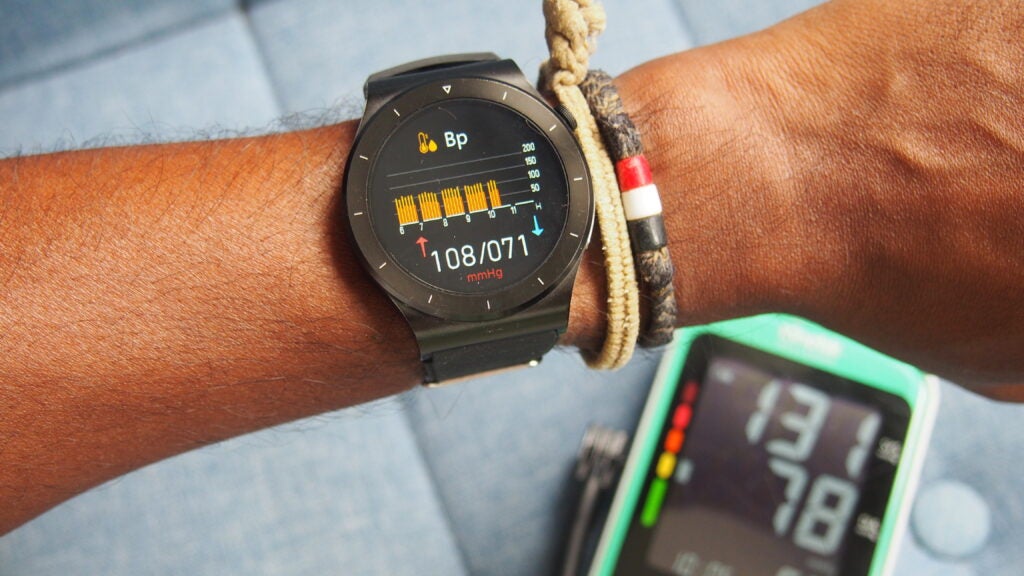
For continuous heart rate readings, the general readings were typically much higher than the reliable continuous readings on a Garmin watch and the more accurate ECG measurements also showed that too. It could be at times 20 bpm higher.
Data like SpO2 readings, respiratory rate and temperature did feel more in line with other devices we compared them against, so if that’s data you do care about, it felt more reliable on that front. In terms of those big features like glucose monitoring and blood pressure, I’m not convinced they’re offering good enough data on the whole.
Fitness tracking and smartwatch features
- Tracks daily steps
- Sleep monitoring
- Sleep tracking from watch and app
MymonX uses what seems to be its own operating system here, or one that feels like the kind of Android-based OS you find on cheaper smartwatches. That’s powered by an ultra-low power nordic52832 chip, which seems to be enough to do the job for a not so demanding operating system.
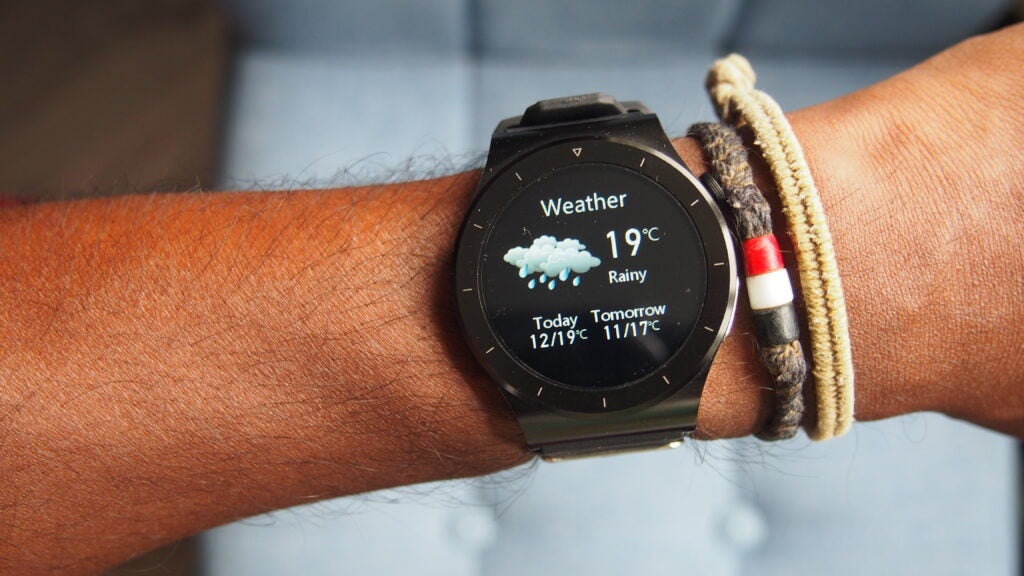
Interacting with the software doesn’t feel particularly slick. You flick to screens as opposed to moving to them like you do on most smartwatches with elements like widgets, menus and watch faces all feeling a bit budget.
You do have some watch faces to pick from, though none really shine on that muted display, while notifications are tucked away when you want to review them. There’s music playback controls here too, though it can’t display currently playing tracks and features like remotely controlling your smartphone’s camera aren’t well executed.
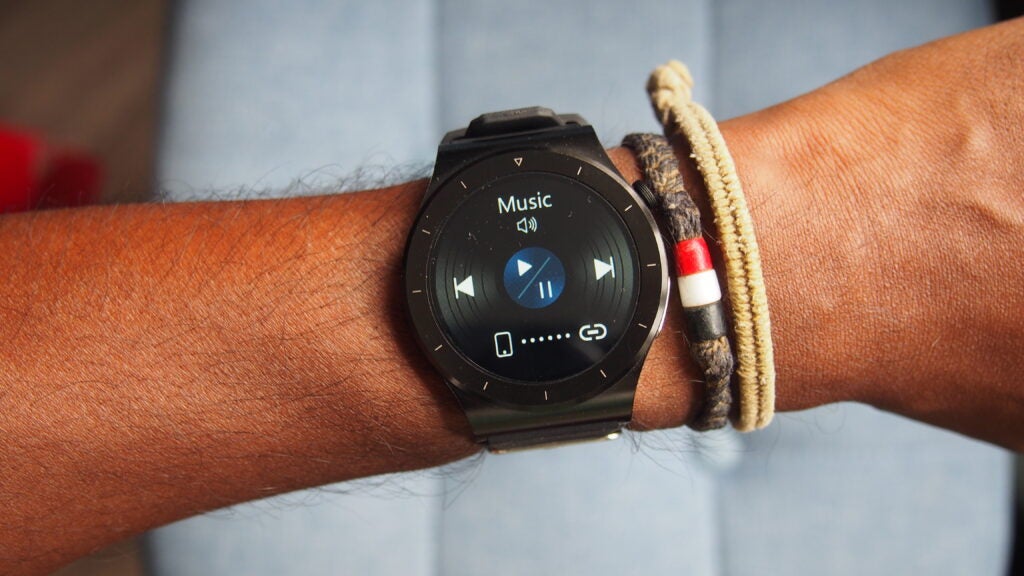
It does have the sensors on board to track daily steps and monitor sleep, and daily step counts were in the ballpark of the same tracking on a Garmin watch and the Oura Ring Gen 3.
It breaks down deep and light sleep stages, along with capturing sleep duration and giving you a short piece of sleep analysis. Sleep duration captured was very close to what Oura and Garmin recorded, while sleep stages in general were roughly in line too. It’s a quite basic presentation of that sleep data in the app, but it seems the reliability of the data has been good.
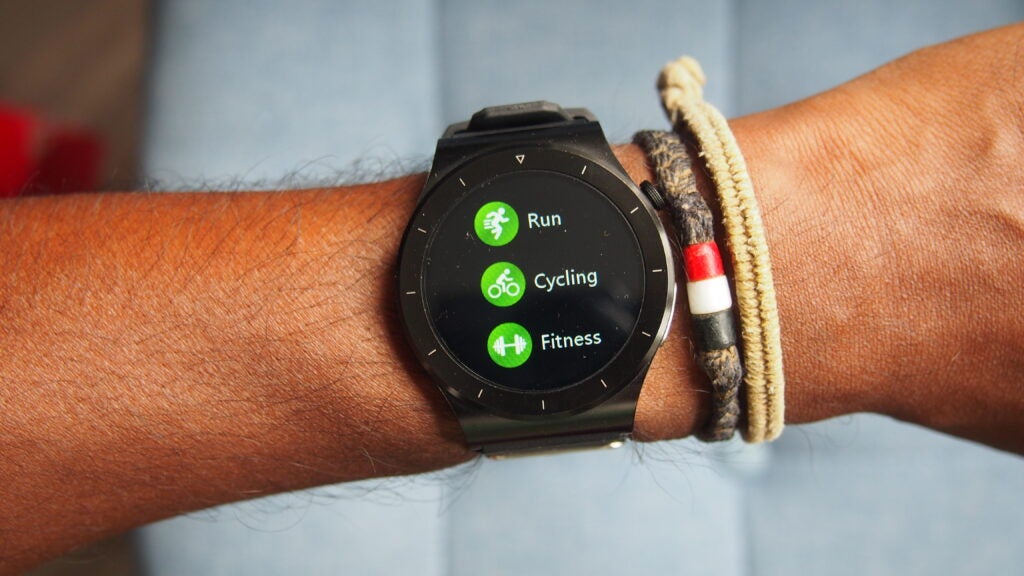
There are some sports tracking capabilities here too, though not particularly good ones. From the watch, there’s profiles of running, cycling, general fitness and things like skipping and table tennis. Everytime I tried to track a workout from the watch, whether it was a run or a general gym workout, it never synced it over to the app and it was like it never happened.
You can launch sports tracking from the app, where you’ll get the GPS tracked route and more metrics, but again this represents yet more disconnect between the watch and the app, which makes this particular part of using the MymonX frustrating.
Battery life
- Up to 15 days battery life
- 30-40 days in standby mode
A highlight for the MymonX is the kind of battery life you’ll enjoy, which despite the more basic nature of the watch software and elements like the display technology used, is still surprising when it’s continuously monitoring multiple vitals at once.
There’s a 200mAh capacity battery that MymonX says can deliver anywhere from 7-15 days battery life. If you leave it in standby mode that jumps to 30-40 days. I saw a daily and overnight battery drop-off of around 10%, which would equate to 10 days.
Unsurprisingly, it uses a proprietary charging cable to power it back up and thankfully it isn’t the terrible kind that does magnetically stay in place in a secure fashion.
Latest deals
Should you buy it?
You want a health smartwatch with good battery life: Despite tracking multiple vitals at all the same time, the MymonX does manage to dish out good battery life
You want the smartwatch for tracking your health: Bottom line, the good data you do get in places doesn’t make up for the cheap-feeling hardware and software you’re getting here.
Final Thoughts
I didn’t have high hopes for the MymonX when I took it out of the box. While it does show signs of being a useful watch to monitor health data, what it’s wrapped up in doesn’t make it worth the money. I wasn’t convinced by the usefulness or value of the glucose tracking or felt it bettered the blood pressure monitoring already offered by Samsung and Huawei.
If you want a good-looking, slick, health focused smartwatch, take the same money and buy a Samsung Galaxy Watch. You might not get something that can track your blood glucose, but you’ll get something in general that’s a lot nicer to have on your wrist and still offer insightful health data. Also check out our Best Smartwatch guide for more options.
How we test
We thoroughly test every smartwatch we review. We use industry standard testing to compare features properly and we use the watch as our main device over the review period. We’ll always tell you what we find and we never, ever, accept money to review a product.
Worn as our main tracker during the testing period
Heart rate data compared against dedicated heart rate devices
FAQs
Yes, the MymonX watch can non-invasively monitor glucose using its optical sensors and AI to deliver continuous and real-time blood glucose readings
No, you cannot make or answer calls from the MymonX watch.
Verdict
The MymonX offers big health monitoring features, but is ultimately let down by hardware and software problems that make it tough to recommend over similarly priced health-focused smartwatches.
Pros
- Comfortable to wear
- Good battery life
- Some good ECG data
Cons
- Not hugely accurate a lot of the time
- Watch and app software very disconnected
- Sports tracking issues
-
Non-invasive glucose monitoringCan determine your glucose measurements without the need for blook pricks. -
ECG measurementsCan measure the electrical activity of the heart to assess your heatlh. -
Blood pressure monitoringCan determine whether you have high or low blood pressure.
Introduction
The MymonX is a smartwatch that promises to track your vitals, including one that hasn’t been offered by any high profile smartwatch.
AITIS, the makers of MymonX, says its watch packs in medical-grade sensors that can non-invasively track glucose, which is something the likes of Apple and Samsung are continually rumoured to be striving to add to their respective smartwatches.
This is also a smartwatch that can track blood pressure, take ECG readings and monitor SpO2, respiratory rate, body temperature, all while offering some sports and fitness tracker features to make it useful outside of the more serious health monitoring time.
It’s a watch that packs in some pretty big and potentially groundbreaking features, so does it deliver where it matters? Here’s my take.
Design and screen
- 51mm case
- 1.3-inch TFT display
- IP68 water resistance level
If you’re hoping that the MymonX is going to bring some serious styling to your wrist, then you’re going to be disappointed. It’s very much in that category of ordinary looking smartwatches and reminds me a lot of the cheaper smartwatches I’ve tested from the likes of Realme, Poco and Mobvoi.

It’s built from stainless steel and a metal alloy with plastic and 316 medical steel around the back and that’s connected to a leather and TPU plastic strap with a traditional watch buckle that has been comfortable to wear and hasn’t caused any sort of irritation.
There’s just the one black colour option with scope to change up the straps, and while it feels pretty well built it’s just quite an uninspiring watch to peer down at.

Weight-wise, it drops on the scales at 200g, so compare that to something like the new Samsung Galaxy Watch 6 Classic (52g-59g) and it’s a little on the heavy side. It measures in at 11.8mm thick, so it’s not a chunky watch at least, and while you don’t feel that weight, it certainly doesn’t disappear on the wrist either.
There’s one physical button to wake up the screen and get into the main menu screen. And below that there’s what looks like a larger, flatter button. That’s actually the electrode to place your finger onto to take ECG measurements.

You’ll be staring into a pretty muted, 1.3-inch, 240 x 230 TFT touchscreen display, which again is the kind of screen you’d associate on much cheaper smartwatches. That does mean you get some colour, but it’s not rivalling the quality you’ll get on an AMOLED. It’s not a hugely bright screen either, with just 3 brightness settings to choose from and you can’t keep the display on 24/7 either.
AITIS does give its watch an IP68 water resistance design, which does mean it can handle some time being submerged in water up to 1.5 metres depth and offers some protection against dust as well.
Health tracking
- Non-invasive glucose tracking
- Blood pressure monitoring
- Takes ECG measurements
This smartwatch is really about what it can offer in terms of measuring your vitals, particularly the promise it can monitor blood glucose levels continuously. No high-profile smartwatch has promised this and most experts I’ve spoken to in this space suggest getting the level of accuracy with non-invasive glucose monitoring is extremely challenging.

Interestingly, MymonX claims this isn’t a medical device and shouldn’t be used in the treatment of any medical condition. Based on my time with it, I’m not sure the data or the experience of grabbing that data feels good enough or better than what other smartwatches currently offer to make it wholly useful on that front.
Starting with the non-invasive glucose monitoring, which MymonX claims is AI-based, non-invasive monitoring and inside of the companion phone app will show real-time readings in mmol/L along with highest and lowest readings.
I wore a Supersapiens glucose monitoring device at the same time as testing the MymonX watch. Like the watch, it’s not designed for medical use, but is similar to the setup of its Freestyle Libre setup for those wanting to closely monitor glucose for health reasons. It’s also an invasively applied device designed to offer accurate data over a 14-day period.

Comparing the readings they generally never seemed to match. The readings on the MymonX didn’t appear to show a spike or drop at times I’d expected it to, like after exercise or after eating a meal and largely the readings just seemed to hover at the same real-time and continuous readings most of the time.
Next was the ECG measurements, which fared a bit better on the accuracy front, but illustrates some of the disconnect between the app and the watch. You start ECG measurements from the app or the watch, with the latter done by placing your finger on the electrode. Taking a recording on the watch itself did work, but data never synced over.

It worked fine when prompting a measurement from the app, which emits a loud beep as it’s taking readings. This generates heart rate, blood pressure and heart rate variability measurements. The ECG measurements in general did match what I grabbed from the Apple Watch and its built-in ECG sensor. So the data looks good, it’s just the execution of getting that data that’s the problem here.
Onto blood pressure monitoring where you can take readings directly from the watch through the optical sensors or you can do the above ECG measurement to get them. Either way, I took readings alongside a dedicated blood pressure monitor and they rarely matched and were generally off my usual readings. You can set your typical readings in the app to calibrate it in the app and without doing that it doesn’t seem highly reliable.

For continuous heart rate readings, the general readings were typically much higher than the reliable continuous readings on a Garmin watch and the more accurate ECG measurements also showed that too. It could be at times 20 bpm higher.
Data like SpO2 readings, respiratory rate and temperature did feel more in line with other devices we compared them against, so if that’s data you do care about, it felt more reliable on that front. In terms of those big features like glucose monitoring and blood pressure, I’m not convinced they’re offering good enough data on the whole.
Fitness tracking and smartwatch features
- Tracks daily steps
- Sleep monitoring
- Sleep tracking from watch and app
MymonX uses what seems to be its own operating system here, or one that feels like the kind of Android-based OS you find on cheaper smartwatches. That’s powered by an ultra-low power nordic52832 chip, which seems to be enough to do the job for a not so demanding operating system.

Interacting with the software doesn’t feel particularly slick. You flick to screens as opposed to moving to them like you do on most smartwatches with elements like widgets, menus and watch faces all feeling a bit budget.
You do have some watch faces to pick from, though none really shine on that muted display, while notifications are tucked away when you want to review them. There’s music playback controls here too, though it can’t display currently playing tracks and features like remotely controlling your smartphone’s camera aren’t well executed.

It does have the sensors on board to track daily steps and monitor sleep, and daily step counts were in the ballpark of the same tracking on a Garmin watch and the Oura Ring Gen 3.
It breaks down deep and light sleep stages, along with capturing sleep duration and giving you a short piece of sleep analysis. Sleep duration captured was very close to what Oura and Garmin recorded, while sleep stages in general were roughly in line too. It’s a quite basic presentation of that sleep data in the app, but it seems the reliability of the data has been good.

There are some sports tracking capabilities here too, though not particularly good ones. From the watch, there’s profiles of running, cycling, general fitness and things like skipping and table tennis. Everytime I tried to track a workout from the watch, whether it was a run or a general gym workout, it never synced it over to the app and it was like it never happened.
You can launch sports tracking from the app, where you’ll get the GPS tracked route and more metrics, but again this represents yet more disconnect between the watch and the app, which makes this particular part of using the MymonX frustrating.
Battery life
- Up to 15 days battery life
- 30-40 days in standby mode
A highlight for the MymonX is the kind of battery life you’ll enjoy, which despite the more basic nature of the watch software and elements like the display technology used, is still surprising when it’s continuously monitoring multiple vitals at once.
There’s a 200mAh capacity battery that MymonX says can deliver anywhere from 7-15 days battery life. If you leave it in standby mode that jumps to 30-40 days. I saw a daily and overnight battery drop-off of around 10%, which would equate to 10 days.
Unsurprisingly, it uses a proprietary charging cable to power it back up and thankfully it isn’t the terrible kind that does magnetically stay in place in a secure fashion.
Latest deals
Should you buy it?
You want a health smartwatch with good battery life: Despite tracking multiple vitals at all the same time, the MymonX does manage to dish out good battery life
You want the smartwatch for tracking your health: Bottom line, the good data you do get in places doesn’t make up for the cheap-feeling hardware and software you’re getting here.
Final Thoughts
I didn’t have high hopes for the MymonX when I took it out of the box. While it does show signs of being a useful watch to monitor health data, what it’s wrapped up in doesn’t make it worth the money. I wasn’t convinced by the usefulness or value of the glucose tracking or felt it bettered the blood pressure monitoring already offered by Samsung and Huawei.
If you want a good-looking, slick, health focused smartwatch, take the same money and buy a Samsung Galaxy Watch. You might not get something that can track your blood glucose, but you’ll get something in general that’s a lot nicer to have on your wrist and still offer insightful health data. Also check out our Best Smartwatch guide for more options.
How we test
We thoroughly test every smartwatch we review. We use industry standard testing to compare features properly and we use the watch as our main device over the review period. We’ll always tell you what we find and we never, ever, accept money to review a product.
Worn as our main tracker during the testing period
Heart rate data compared against dedicated heart rate devices
FAQs
Yes, the MymonX watch can non-invasively monitor glucose using its optical sensors and AI to deliver continuous and real-time blood glucose readings
No, you cannot make or answer calls from the MymonX watch.























